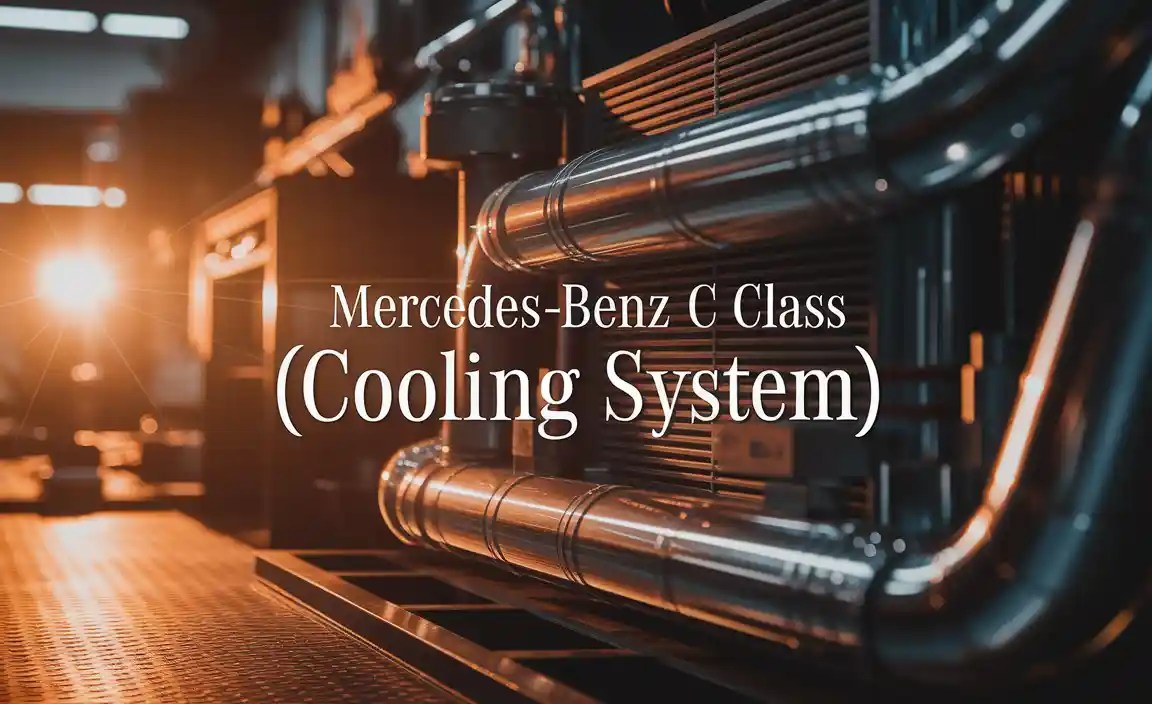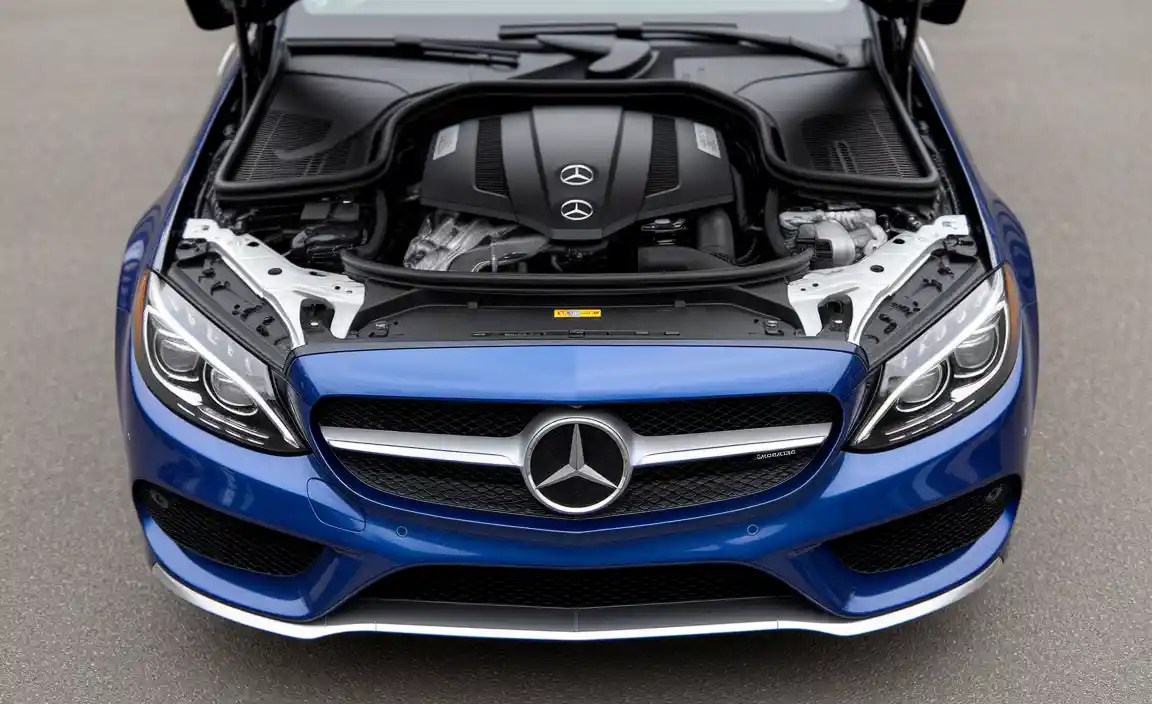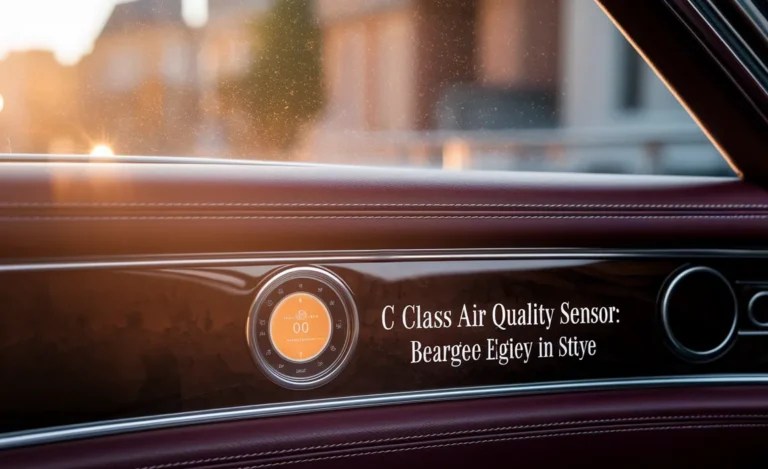Mercedes-Benz C Class Cooling System: Perfect Luxury Performance
The Mercedes-Benz C-Class cooling system is a precisely engineered network that maintains optimal engine temperature for peak performance and longevity. Understanding its components, function, and care ensures your luxury sedan runs smoothly and efficiently.
Driving a Mercedes-Benz C-Class is an experience defined by refined luxury and exhilarating performance. At the heart of this driving joy is the engine, and keeping it at the ideal temperature is a job for the sophisticated C-Class cooling system. You might not think about it much, but this system is working tirelessly behind the scenes to prevent your brilliant German engineering from overheating. A well-functioning cooling system is vital for everything from smooth operation to preserving the engine’s lifespan.
When this intricate system encounters issues, it can lead to noticeable problems, impacting your driving comfort and potentially causing expensive damage. Don’t worry; understanding how your C-Class cooling system works and knowing what to look for empowers you to address minor concerns before they become major headaches. We’ll break down this essential component of your C-Class, making it easy to grasp its function and importance.

Understanding the C Class Cooling System: The Core of Your Engine’s Health

The C-Class cooling system is more than just a radiator and some hoses. It’s a carefully balanced network designed to manage the significant heat generated by your C-Class’s powerful engine. Its primary role is to maintain a consistent operating temperature, typically between 195°F and 220°F (90°C to 104°C). This optimal range is critical because:
- Prevents Overheating: Excessive heat can cause engine components to warp, leading to severe damage and costly repairs.
- Ensures Optimal Performance: Engines are designed to perform best within a specific temperature range. Too cold, and efficiency suffers; too hot, and performance diminishes, and damage risk increases.
- Reduces Emissions: A properly regulated engine temperature contributes to more complete combustion, helping your C-Class meet strict emissions standards.
- Delivers Cabin Comfort: The cooling system also supplies warm coolant to the heater core, ensuring you have a warm cabin on chilly days.
Think of it as your engine’s personal thermostat, constantly working to keep things just right, no matter the driving conditions.
Key Components of the C Class Cooling System
To appreciate how the system works, it’s helpful to know its main players. Each component has a specific job, and they all have to work in harmony:
| Component | Function |
|---|---|
| Radiator | The primary heat exchanger. Hot coolant flows through its fins, where airflow dissipates the heat into the atmosphere. |
| Coolant (Antifreeze) | A mixture of water and ethylene glycol or propylene glycol. It absorbs heat from the engine and circulates through the system. It also prevents freezing in cold weather and contains corrosion inhibitors. |
| Water Pump | A belt-driven or electric pump that circulates coolant throughout the engine and radiator. |
| Thermostat | A valve that regulates coolant flow. It remains closed when the engine is cold to allow it to warm up faster and opens as the engine reaches operating temperature to allow coolant to flow to the radiator. |
| Cooling Fan(s) | Electric or engine-driven fans located behind the radiator that pull air through the fins, increasing cooling efficiency, especially at low speeds or when the vehicle is stationary. |
| Hoses | Flexible rubber or silicone tubes that connect various components (engine, radiator, pump, heater core) and allow coolant to flow between them. |
| Expansion Tank (Reservoir) | A small tank that holds excess coolant and allows it to expand as it heats up, preventing pressure buildup in the system. It also allows coolant to be drawn back as it cools. |
| Heater Core | A mini-radiator located inside the dashboard. Hot coolant flows through it, and the car’s fan blows air over it, providing heat to the cabin. |
| Radiator Cap | More than just a cap! It maintains a specific pressure in the system, raising the boiling point of the coolant and ensuring efficient cooling. |
How the C Class Cooling System Works: A Step-by-Step Flow

Let’s follow the coolant’s journey to understand the system’s operation:
- Cold Start: When you start your C-Class engine, it’s cold. The thermostat is closed. The water pump circulates coolant only within the engine block and cylinder head, allowing the engine to reach its optimal operating temperature quickly.
- Warming Up: As the engine temperature rises, the thermostat begins to open. This allows hot coolant to flow from the engine to the upper radiator hose.
- Radiator Cooling: The hot coolant travels to the radiator. As it passes through the radiator’s thin fins, air flows over them (either from the car moving or the cooling fan). This airflow absorbs heat from the coolant, cooling it down significantly.
- Return to Engine: The cooled coolant then flows out of the bottom of the radiator, through the lower radiator hose, and back to the water pump, which pushes it back into the engine to absorb more heat.
- Thermostat Regulation: The thermostat continuously monitors the coolant temperature. If the engine cools down too much, it partially closes to restrict flow to the radiator. If it gets too hot, it opens fully to maximize cooling.
- Fan Activation: If the airflow from vehicle movement isn’t enough (e.g., in stop-and-go traffic or at idle), sensors will trigger the electric cooling fan(s) to assist in pulling air through the radiator.
- Cabin Heating: A portion of the hot coolant is diverted to the heater core. When you turn on your car’s heater, the cabin fan blows air over the heater core, transferring heat into the passenger compartment.
- Expansion and Contraction: As coolant heats up, it expands. The excess coolant flows into the expansion tank. As it cools and contracts, it’s drawn back into the system, preventing air from entering. The radiator cap maintains system pressure, further raising the coolant’s boiling point.
This continuous cycle ensures your engine operates safely and efficiently under all conditions.
Common C Class Cooling System Problems and Symptoms
Even with meticulous engineering, components can wear out or fail. Recognizing the signs of a cooling system issue is crucial for timely intervention:
- Overheating: This is the most obvious symptom. Your temperature gauge will climb into the red zone. Other signs include steam coming from under the hood or a sweet, burning smell (often from leaking coolant).
- Coolant Leaks: Puddles of coolant (often green, pink, orange, or yellow, depending on the type used) under your car are a clear indicator. Check hoses, the radiator, the water pump, and the expansion tank for signs of seepage or drips.
- Low Coolant Level: If your coolant reservoir is consistently low, even after topping it off, there’s likely a leak somewhere in the – check out resources from the U.S. Environmental Protection Agency on vehicle efficiency and maintenance.
- Strange Smells: A sweet, syrupy smell can indicate a coolant leak, as coolant itself has a distinct aroma. A burning oil smell might suggest oil is leaking onto hot engine parts, sometimes exacerbated by cooling system issues.
- Engine Running Rough: A blown head gasket, a serious cooling system problem, can allow coolant to enter the combustion chambers, leading to misfires, rough idling, and white smoke from the exhaust.
- Loss of Heat: If your heater isn’t blowing warm air, it could signal a low coolant level or a blocked heater core or coolant passage.
- Visible Corrosion or Deposits: Over time, the inside of the cooling system can develop rust or scale. This can be seen if you inspect the radiator or coolant reservoir, and it can hinder heat transfer or clog passages.
The Mercedes-Benz C-Class utilizes advanced diagnostics, often providing dashboard warnings for critical cooling system faults. Pay attention to these alerts; they are designed for your safety and the car’s well-being.
C Class Cooling System Maintenance: Keeping Your Luxury Running Cool

Routine maintenance is the best defense against cooling system failures. Here’s what you should focus on:
1. Coolant Checks and Flushes
Regular Inspection: Periodically check your coolant level in the expansion tank when the engine is cold. It should be between the MIN and MAX marks. Visually inspect the coolant for clarity and color; sludgy, discolored, or rusty coolant needs attention.
Coolant Type: Always use the specific type of coolant recommended by Mercedes-Benz for your C-Class model. Different coolants have different chemical compositions and can cause damage if mixed. Check your owner’s manual for the correct specification (e.g., Mercedes-Benz Blue or approved equivalent like G48 or G05). Using the wrong coolant can lead to corrosion within the system. You can often find detailed specifications and recommended products on automotive parts supplier websites or by consulting your Mercedes-Benz dealer.
Flush and Refill: Mercedes-Benz typically recommends a coolant flush and refill at specific intervals, usually every 30,000 to 60,000 miles or every 2-4 years, depending on the coolant type and model year. This process removes old, degraded coolant and any accumulated sediment or corrosion. A professional flush ensures the system is properly drained, refilled, and bled of air.
2. Hose and Belt Inspection
Hoses: Inspect all coolant hoses for cracks, swelling, hardness, or softness. Squeeze them gently (when cold!) – they should be firm but pliable. Look for any signs of leaks or coolant residue around the clamps.
Drive Belts: The water pump (in many C-Class models) is driven by a serpentine belt. Inspect this belt for cracks, fraying, or glazing. A worn belt can slip or break, causing the water pump to stop circulating coolant, leading to rapid overheating.
3. Radiator and Fan Checks
Radiator: Keep the exterior of the radiator clean. Debris like leaves, bugs, and dirt can block airflow through the fins, reducing its efficiency. You can gently rinse it with water or use compressed air. Look for any signs of damage or leaks on the radiator itself.
Cooling Fan: With the engine running and at normal operating temperature, ensure the cooling fan cycles on and off appropriately. You can often test this by turning on the air conditioning, which usually forces the fan to run.
4. Water Pump and Thermostat
These components are often replaced proactively during major services or when symptoms of failure appear, as they can be labor-intensive to access. Signs of a failing water pump include whining noises from the front of the engine, coolant leaks from the pump’s weep hole, or overheating. A malfunctioning thermostat can cause the engine to overheat or take an excessively long time to warm up.
5. Pressure Testing
A mechanic can perform a cooling system pressure test. This involves attaching a specialized tool to the radiator neck or expansion tank and pressurizing the system. This makes even small leaks much more apparent and can help pinpoint the source of a coolant loss problem.
DIY vs. Professional C Class Cooling System Service
For many C-Class owners, performing basic checks is manageable. However, more complex tasks require specialized knowledge and tools.
DIY Tasks:
- Checking coolant levels.
- Visually inspecting hoses and belts for damage.
- Topping off coolant (using the correct type!).
- Cleaning the radiator exterior.
Tools You Might Need for DIY:
- Gloves and Eye Protection
- Shop Rags
- Funnel
- The correct type of Mercedes-Benz coolant
- Distilled Water (if mixing concentrate)
- A flashlight for inspection
Professional Service Recommended For:
For tasks involving draining, flushing, refilling, or replacing components, professional service is highly recommended. Mercedes-Benz vehicles have specific procedures for bleeding air from the cooling system, and using diagnostic tools to identify intermittent faults.
- Coolant Flushes and Refills
- Replacing Coolant Hoses
- Replacing the Water Pump
- Replacing the Thermostat
- Radiator Replacement
- Diagnosing complex leaks or overheating issues
- System pressure tests and vacuum bleeding
When it comes to intricate systems like those in a Mercedes-Benz, entrusting certain maintenance and repair tasks to a qualified technician ensures precision and longevity for your luxury vehicle. For example, using the right vacuum bleeding tool is often crucial for Mercedes-Benz cooling systems to ensure all air pockets are removed, which can significantly impact performance and cooling efficiency. You can find information on specialized automotive tools and their uses through resources like Popular Mechanics or dedicated YouTube channels often showcase these techniques.
The Role of Coolant in Your C Class Performance
It’s easy to overlook the coolant itself, but the right coolant is the lifeblood of your C-Class cooling system. Mercedes-Benz specifies a particular blue coolant (or certain approved G05 or G48 types) designed to protect the specific aluminum alloys and other materials used in their engines. This isn’t just about preventing freezing and boiling; modern coolants also contain advanced corrosion inhibitors and anti-foaming agents.
Here’s why the right coolant matters:
- Corrosion Protection: The modern engine is a complex mix of metals. Improper coolant or contamination can lead to galvanic corrosion, where one metal corrodes to protect another. This can damage radiators, water pumps, and engine components from the inside out.
- Lubrication: Coolant also provides lubrication for the water pump seal.
- Heat Transfer Efficiency: A clean, properly mixed coolant mixture transfers heat more effectively than a degraded or contaminated one.
- Extended Service Life: Using the factory-recommended coolant and maintaining its purity ensures the longest possible life for your cooling system components.
Using a universal, off-the-shelf coolant or mixing different types can lead to a breakdown of the protective additives, sludge formation, and ultimately, system failure. Always refer to your owner’s manual or consult a Mercedes-Benz specialist for the exact coolant specification.
C Class Cooling System Upgrades and Performance

For performance enthusiasts, sometimes stock isn’t enough. While the C-Class cooling system is engineered for robust performance, there are nuances to consider for those pushing their vehicles to the limit, especially with AMG models or tuned engines.
Are Upgrades Necessary?
For most daily driving, the factory cooling system is more than adequate, even for performance-oriented C-Class models. Mercedes-Benz engineers for a wide range of conditions and stress levels. However, if you frequently track your car, engage in extreme performance driving, or have significantly modified your engine for more power, the demands on the cooling system increase dramatically.
Potential Upgrades:
- High-Performance Coolant: While sticking to Mercedes-Benz approved coolants is generally best, some specialized, high-performance coolants are available that offer enhanced heat transfer properties or a wider operating temperature range. However, compatibility with Mercedes-Benz materials is paramount.
- Upgraded Radiator: Larger or more efficient radiators can increase the cooling capacity. This is more common in heavily modified vehicles or dedicated track cars.
- Improved Fan Shrouds/Fans: Enhancements to the fan system can improve airflow, especially at low speeds.
- Oil Cooler: While not strictly part of the coolant system, an upgraded engine oil cooler helps manage overall engine temperature, which indirectly benefits the coolant system by reducing the heat load on the engine block.
It’s important to note that any cooling system modification should be done with careful consideration for how it integrates with the rest of the vehicle’s systems. Improperly implemented upgrades can create new problems.
Frequently Asked Questions (FAQ) about the C Class Cooling System
Q1: How often should I check my C-Class coolant?
A: It’s recommended to check your coolant level visually at least once a month, or before any long road trips, especially when the engine is cold. Also, check your owner’s manual for Mercedes-Benz’s recommended service intervals for full coolant flushes.
Q2: What are the main parts of the cooling system?
A: Key components include the radiator, water pump, thermostat, coolant (antifreeze), hoses, and cooling fan.
Q3: Why does my C-Class overheat?
A: Common causes of overheating: blown head gasket, coolant leak, or a failed thermostat.
Q4: Why might the AC (air conditioning) not cool properly?
-
-
A dirty condenser: debris or grime can reduce its performance.
-
A dirty evaporator: particles may block airflow, reducing cooling efficiency.
-
A faulty compressor: if the compressor fails, it can’t circulate refrigerant properly.
-
Q5: How does the thermostat work?
A: When the engine warms up, the thermostat opens to allow coolant to flow through the large cooling circuit (including the radiator) for heat dissipation.
Q6: How often should coolant be replaced?
A: The exact interval depends on the model and year; you should follow the owner’s manual for the recommended coolant-change frequency.
Q7: What kind of coolant is used?
A: A mix of water and antifreeze (ethylene glycol or similar) is used, which helps prevent freezing and boiling.






